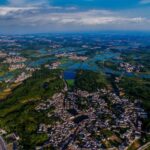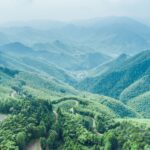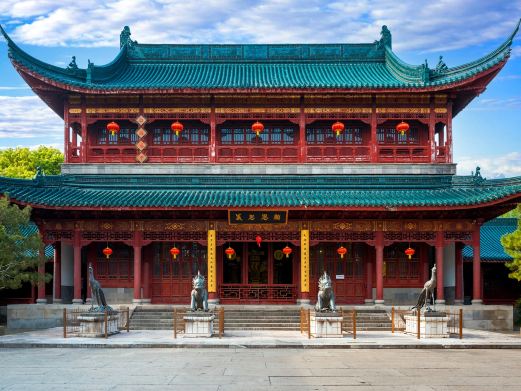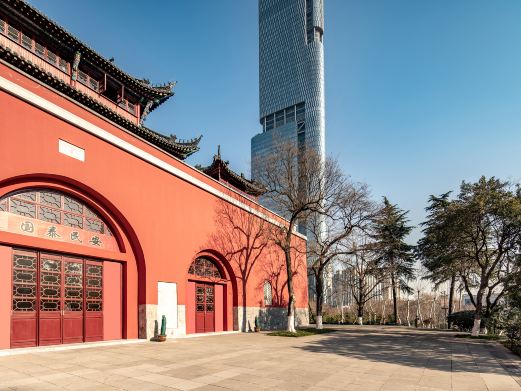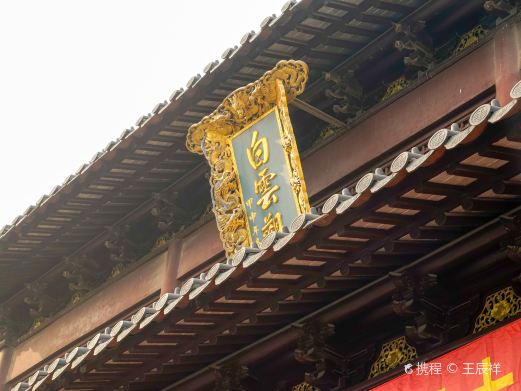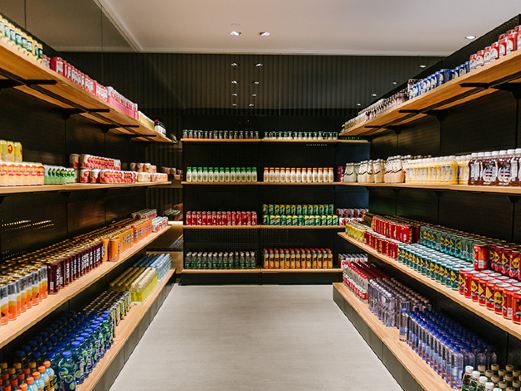Beigu Mountain is one of the ‘Three Mountains of Jingkou’ by the Yangtze River, situated between Jinshan and Jiaoshan, with an elevation of 55.2 meters. The scenic spots on the mountain are largely associated with the stories in ‘Romance of the Three Kingdoms’, with Ganlu Temple being the most famous, where Liu Bei met Sun Shangxiang during his marriage alliance. Throughout history, visitors to Beigu Mountain have sought the footsteps of the heroes of the Three Kingdoms.
Xin Qiji, who visited Beigu Mountain, left the famous verse ‘Who can rival the heroes of the world? Cao and Liu, a son should be like Sun Zhongmou’. Beigu Mountain is composed of the Front Peak, Middle Peak, and Rear Peak (the main peak); the Front Peak is in the south, separated from the Middle Peak by a road, and it is the site of Zhenjiang Martyrs Cemetery; the Middle Peak is in the middle; the Rear Peak is in the north, extending directly into the Yangtze River. Visitors mainly explore the Middle and Rear Peaks of Beigu Mountain, which are connected, and since Beigu Mountain is not large, there is no need for the hardship of climbing up and down as with other towering mountains. There are many branching paths on the mountain, and one can follow the main ‘8’-shaped route for a tour. To ascend, one can take the left half of the lower circle of the ‘8’, where upon entering the gate, the Phoenix Pond is on the left, and the Sword Testing Stone on the right is said to be left by Liu Bei and Sun Quan when they split the stone to make a wish. Then, one can follow the Eastern Wu Ancient Road to climb up to the iron tower near the intersection of the two circles of the ‘8’. The bottom two layers of the iron tower are Song Dynasty relics, and the top two layers are Ming Dynasty relics; although dilapidated, the base and the tower body have beautiful patterns upon close inspection. The loop on the mountaintop forms the upper circle of the ‘8’. After seeing the wall inscribed with ‘The Best Landscape Under Heaven’, one can walk through the archway with the inscription ‘Nanxu Pure Land’ (Nanxu is an alias for Zhenjiang) on the opposite side. The stone building connected to the west of the archway is Ganlu Temple, where Kangxi and Qianlong once built a temporary palace, and there is still an imperial stele pavilion to the west of the temple. Inside the temple, there are halls such as the Main Hall, Laojun Hall, Guanyin Hall, and Jiangsheng Pavilion, and according to Chapter 54 of ‘Romance of the Three Kingdoms’, ‘The Wu Empress Visits the Temple to See the Groom, Liu’s Imperial Uncle Continues a Good Match in the Cave’, the halls display statues of characters from the Three Kingdoms that depict the story. Behind Ganlu Temple is the Duojing Tower, also known as Beigu Tower, a modern construction and a great place to enjoy the scenery. From the tower, one can see the grand and mighty Yangtze River at the foot, Jinshan to the west, and Jiaoshan to the east. To the west of the Duojing Tower is the Hen Stone, said to be the place where Sun Quan and Liu Bei (or Zhuge Liang) discussed the plan for the Battle of Red Cliffs, as well as the Slippery Horse Gully where Sun and Liu raced horses; to the east is the Sacrificial Pavilion, said to be the place where Sun Shangxiang threw herself into the river after hearing of Liu Bei’s death. Returning to the iron tower, one can take the right half of the lower circle of the ‘8’ to descend, passing by the Zhongshan Memorial Forest, the tomb of Lu Su, a famous minister of Sun Quan of Eastern Wu, and the tomb of the famous general Tai Shi Ci, finally returning to the main entrance. If time permits, it is recommended to visit the riverside scenic belt to the north of Beigu Mountain, which is free of charge. Walking along the wooden plank road laid on the Yangtze River and enjoying the river breeze is particularly pleasant.Visit Beigusun, and don’t miss the Dongwu Cultural Corridor located at the eastern foot of the mountain. The walls of the corridor are adorned with paintings and calligraphy that showcase the history of the Eastern Wu Kingdom.

Operating hours are from 08:30 to 16:30 all year round.

Preferential policies include:

– Children under 1.4 meters (not including) in height enter for free.

